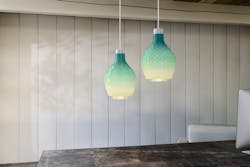Signify boss: Company is on track with environmental and health goals
Signify might be struggling to restore sales and profit growth, but that hasn’t stopped it from making steady progress at achieving its goals for environmental and social wellbeing.
The world’s largest lighting company is in the middle of its second “Brighter Lives, Better World” five-year plan to increase sustainability, wellness, and equality activities. It recently reported that it is on course to hit most of the objectives, which come due in 2025.
One of the targets is to increase the percentage of revenue it derives from sales of “circular” goods, which it defines as “products that can be reprinted, refurbished, reused or recycled.” It is aiming for 32% by 2025. At the end of 2022, it hit 29%, a number that CEO Eric Rondolat said puts Signify “on track” for the 2025 objective and marks a significant rise from the 16% of baseline year 2019. Most of the revenue related to sales of luminaires, he said.
Circular products include 3D printed luminaires, where Signify’s offerings include a pendant line called Coastal Breeze that uses material from discarded fishing nets as manufacturing filament.
Like with circular products, Rondolat said the company is well on the way toward its target of selling products that address human wellness, be it horticultural lighting for food security (although that sector has been experiencing a slowdown), lighting offices to support circadian health, or lighting spaces for safety and security.
The only area where the company is not yet on track with its 2025 goal is “women in leadership,” where Signify is targeting to have 34% of leadership roles filled by women in 2025. At the end of 2022 the percentage was 28%. While that was up from 2019’s 17% and was also better than a year ago, “we are slightly off track,” Rondolat said. In the fourth quarter, Signify implemented new measures for hiring practices and internal talent development to address the gap, he noted.
Rondolat provided his sustainability update during a recent conference call with analysts to discuss fourth-quarter and year-end 2022 financial results. Sales for the quarter fell by 8.8% on a comparable basis, to €1.98 billion, and net income for the quarter tumbled 49.5% to €86 million from €170 million. The uncertain global economic environment prompted the Signify boss from providing a sales projection for 2023.
But he was resolute that Signify would continue to meet Brighter Lives, Better World objectives, where measures have also included zero waste to landfills and using 100% renewable electricity.
“We brought new innovative and sustainable lighting solutions to our customers and continued to make progress towards doubling our impact on environment and society,” Rondolat said in summing up the program’s 2022 progress.
When Signify launched Brighter Lives, Better World 2025 in 2020, it included UV-C disinfection equipment in the health category. In its latest update, it did not specifically mention UV-C in the context of the program. UV-C is probably still part of it, but Signify has scaled back its UV-C operations.
While corporate ESG (environmental, social, and governance) programs in general can sometimes hint at self-congratulations or greenwashing, they can also be taken as good faith, face value efforts. They also tend to come at a financial cost, which could be a contributing factor in Signify’s sales and profit fall.
Signify’s first five-year Brighter Lives, Better World initiative ran from 2016 to 2020 and finished with Signify “outperforming on most of the ambitious commitments set when the program launched,” the company declared at the end of the run.
MARK HALPER is a contributing editor for LEDs Magazine, and an energy, technology, and business journalist ([email protected]).
For up-to-the-minute LED and SSL updates, follow us on Twitter. You’ll find curated content and commentary, as well as information on industry events, webcasts, and surveys on our LinkedIn page and our Facebook page.

Mark Halper | Contributing Editor, LEDs Magazine, and Business/Energy/Technology Journalist
Mark Halper is a freelance business, technology, and science journalist who covers everything from media moguls to subatomic particles. Halper has written from locations around the world for TIME Magazine, Fortune, Forbes, the New York Times, the Financial Times, the Guardian, CBS, Wired, and many others. A US citizen living in Britain, he cut his journalism teeth cutting and pasting copy for an English-language daily newspaper in Mexico City. Halper has a BA in history from Cornell University.





